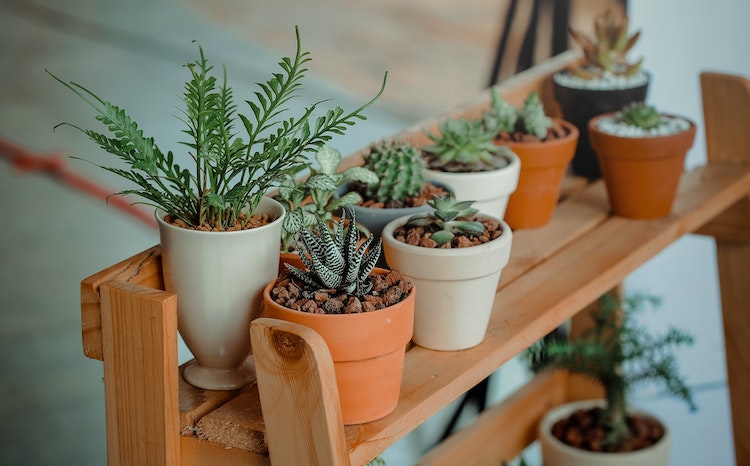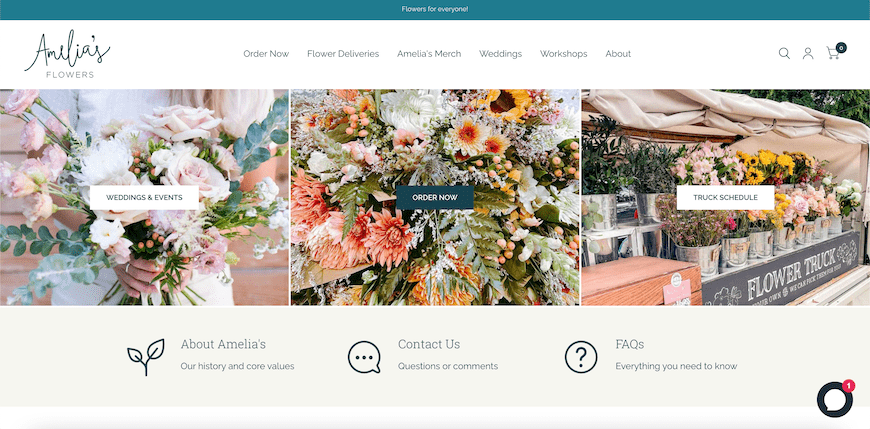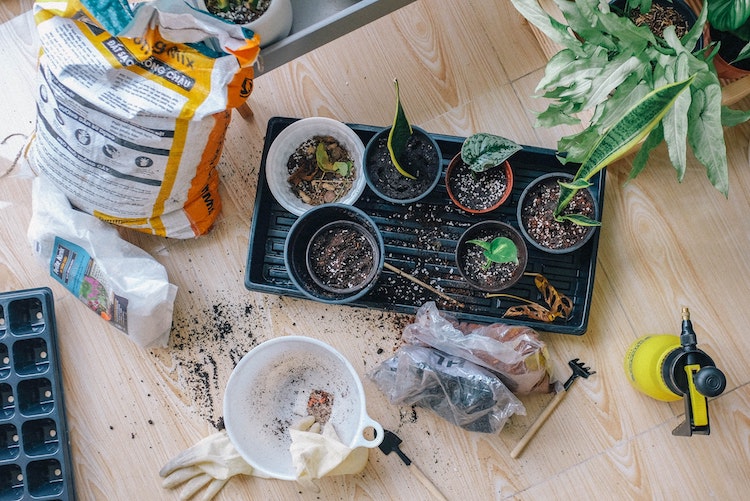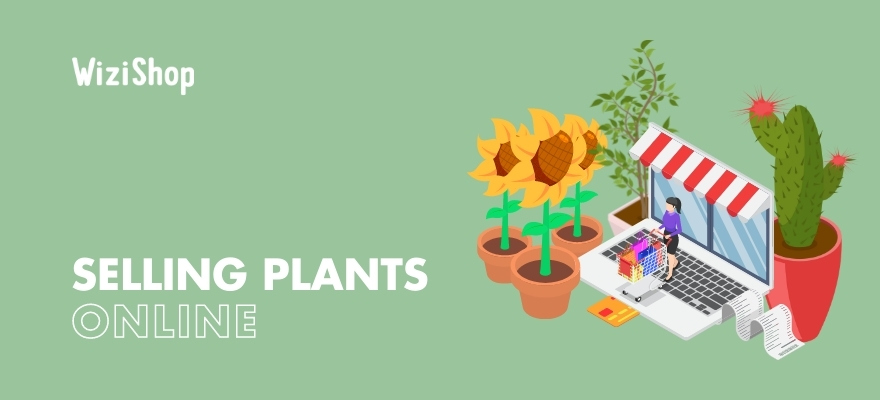Plants are wonderful additions to both indoor and outdoor environments for a number of reasons. They can help improve air quality, add to the ambiance of any living space, and even reduce stress.
Although plants have always been popular items, the interest in purchasing them online increased significantly during the height of the COVID-19 pandemic. People were spending greater amounts of time at home, and many headed to the internet to find their botanical bliss due to brick-and-mortar plant shops facing temporary closures.
Although most physical locations have reopened, plant sales on the web continue to grow…great news if you’ve been considering starting your own online plant store!
In this guide, we’ll go through the various steps required to launch a plant-selling business, providing detailed advice to ensure that you’re on the right track.
1. Pick your niche

When it comes to selling plants online, you’ll have a wide range of options from which to choose! As you work on deciding on niche products for your business, you’ll want to consider not just your favorite types of plants but also what’s in demand with your ideal customer and what you can sustainably grow or source in your area. To inspire your brainstorming, here are some popular types of products to think about selling.
- Indoor plants: This category includes any kind of plant that people can keep inside, in the home or at the office, for instance. From potted roses, orchids, and lilies to ferns, cacti, herbs, succulents, and air-purifying superheros like spider plants, there are plenty of choices available.
- Floral arrangements: If you’re skilled in the art of arranging flowers, putting gorgeous combinations together for your customers to either gift to others or enjoy for themselves, selling floral arrangements online could be ideal for you.
- Outdoor plants: These plants tend to need a lot more space to flourish. While some outdoor plants are hardier than others, you’ll want to think about your target market’s climate when choosing what to sell.
- Bulbs and seeds: Cater to gardeners who like starting from scratch by selling bulbs and seeds. This type of product has the added advantage of being much easier to ship than live plants!
- Terrarium kits: If you’d like to offer something a little different, consider selling plants and supplies that allow your customers to build terrariums, tiny gardens housed inside sealable glass containers, from the comfort of home.
- Decorative planters: Sold with plants inside them or on their own, these containers can feature all kinds of styles and be used to decorate shoppers’ indoor and outdoor spaces.
- Plant care: This category of goods includes things like soil, fertilizer, plant food, etc. It’s also a great way to take advantage of cross-selling, offering a variety of products designed to help people care for the plants you sell!
In addition, you’ll have to decide on the kind of business model you’d like to use. For example, are shoppers going to be able to buy single/multiple items from you whenever they wish? Or perhaps you’ll instead offer a subscription service, allowing your customers to receive recurring shipments of their favorite blooms or be surprised with a new plant every month.
You might alternatively opt to launch a service that provides plants for a variety of special occasions, corporate events, etc. or offer one-on-one consultations with clients, working as a kind of personal plant shopper to assist them with finding the best types of flowers and other greenery to suit their needs. It’s completely up to you!
2. Source your plants

After you determine exactly what you want to sell online, you’ll need to think about where you’ll obtain them. After all, you can’t begin selling plants until you actually have them in stock!
You’ll have several options in terms of where you’ll be able to source plants for your business. The right one for you is going to depend on your budget, available resources, climate, and personal preferences.
Grow your own plants
If the maximum amount of control over your supply is what you’re after, you’ll probably want to grow your own plants. This option is great for green-thumbed entrepreneurs who enjoy getting their hands dirty and growing a variety of plants. What’s more, it helps eliminate the extra complexities of working with numerous suppliers to obtain items to sell.
However, if you want to grow your own plants, you’ll need to be very well versed in plant care and prepared to invest in the right equipment and significant amount of time required to properly perform this activity. You must also take the climate where you live into account. Are growing conditions favorable all year or will you realistically only have 3 to 4 months to produce your supply?
In addition, take a look around at the space you have available for growing and storing your products, both indoors and outdoors. Depending on what types of plants you plan on selling, you may find that you quickly run out of room as your business starts to pick up speed.
Nevertheless, growing your own plants may allow you to develop a deeper connection with the goods you sell. This will make it possible for you to provide your customers with even more detail regarding your plants’ origins and show all the care that you’ve put into cultivating your plants, from seedlings to full blooms!
Work with a plant supplier
A strategy that’s generally more convenient for most sellers is to obtain their plants from a supplier, such as a plant wholesaler or a local greenhouse. Suppliers are likely to have a pretty good selection of plants available for purchase at decent prices, resulting in higher profits for you when you resell the plants with your own branding.
As you look for suppliers to collaborate with, be sure to check out different options. The suppliers you come across may very well have different minimum order rates, some of which may not be a great fit for your budget when you’re just starting out. Furthermore, some may offer additional services and support to further assist you.
Keep in mind that your business is only going to be able to sell plants that you can obtain from your supplier, which may limit your ability to meet the demands of your customers. It’s therefore generally advisable to work with multiple suppliers. This improves your chances of still being able to source a particularly popular item if it’s out of stock at one location.
If possible, try to work with plant suppliers in your local area. Being able to pick up your wholesale orders yourself rather than having them shipped from hundreds of miles away will help keep your costs lower and decrease the chances of your plants getting damaged during the journey.
3. Take photos of your plants

As with any type of product sold on the web, it’s essential that you provide your potential customers with high-quality photos of your plants to draw their attention and entice them to buy.
Remember that they won’t be able to see or touch the items in person before making a purchase. All the important sensory details must therefore be communicated via the images that you offer on your site and across social networks to be able to make your first online sale and all those that follow.
If you have the budget, hiring a professional photographer to shoot photos of your plants is often the most efficient strategy. However, you’ll likely be able to capture great product images yourself via a DIY approach even if you don’t have tons of experience in photography. Here are a few areas to pay particular attention to, along with some tips on achieving the best photos possible for your plant business!
Lighting
Natural lighting is ideal for plant photography, as it’ll give shoppers the most accurate vision of what your plants actually look like. Speaking of accuracy…stay away from filters for your plant photos. Although you’ll want your products to look as amazing as possible, using filters may result in disappointing customers if the item they ordered appears completely different from what they saw online.
Types of photos
When it comes to your product pages, it’s best to provide a variety of photos for each item you sell on your website. Shoot images from various angles and include close-up shots to give visitors the best idea of what your plants are like in real life. Aesthetics are very important with plant sales, so the more you’re able to convey colors, textures, and other details in your images, the better!
Besides photographing your products on their own, think about creating lifestyle shots to help shoppers imagine your plants in different environments. For instance, depending on the plant, you might take photos of it in an office, a bedroom, or an outdoor space like a patio. You can also group different plants together and consider more creative shots for your social networks.
Camera
If you’re going to be taking your own product photos, the general rule is to buy the best photography equipment that you can afford. This will usually result in the most professional results. That being said, many smartphones today feature advanced camera technology that can produce really nice images!
Your smartphone is also going to be the most convenient option for when you want to snap images on the go or create other kinds of visual content for your online store or social media. Video tutorials, behind-the-scenes photos or videos, Q&A sessions, etc. are all excellent ways to boost brand awareness and audience engagement.
4. Create your ecommerce website

Amelia’s Flowers, a Nashville-based florist with both online and offline offerings
When deciding where to sell your plants on the internet, know that you have different options from which to choose.
Some e-merchants opt to put their products for sale on online marketplaces like Etsy or Amazon, as these ecommerce solutions handle many aspects of store management themselves, allowing for a relatively hands-off approach for sellers. In addition, online marketplaces tend to attract shoppers who are already interested in what you’re selling, providing a built-in audience.
However, it’s important to note that these kinds of ecommerce platforms often come with hefty transaction and/or listing fees, which can quickly eat away at your profits. Furthermore, any online marketplaces will generally have a long list of regulations that sellers must follow in order to create listings on the platform. For these reasons, many e-merchants find that launching their own online stores is the best plan of action.
Of course, if you’re going to create your own ecommerce site, you’ll want to be sure that you select a great website builder to accompany you. With the WiziShop ecommerce platform, you get an all-in-one solution to turn your budding plant business idea into a truly successful venture!
Begin by choosing from a wide range of themes to create a homepage that accurately reflects your vision for your brand. Then, easily add your products to your site, including photos and descriptions to further entice shoppers to make a purchase.
While you’ll want to incorporate standard details, such as plant size and species, in your product descriptions, you can also take advantage of this space to offer supplementary helpful information, for example, plant care advice or ratings for how difficult it is to grow each plant, to better assist your customers in their buying decisions.
When using WiziShop for your ecommerce site, you’ll be able to not just launch your plant business but also help it to grow! Take advantage of free training on various ecommerce topics, over 400 integrated features to boost your store’s conversions, assistance from our knowledgeable and friendly team of Business Coaches, and a plethora of tools created to optimize your site’s technical SEO.
What’s more, you’ll get to enjoy a 7-day free trial, with no strings attached!
Try WiziShop free for 7 days
THE EASIEST NO-CODE ECOMMERCE SOLUTION✅ No credit card required
✅ Access to all features
✅ No commitment
5. Decide how to price your plants

When launching a new business, it can be tricky figuring out how much money to charge for your store’s offerings, regardless of what you sell. However, it’s worth spending some time researching the market to determine the right prices for your plants. With the right pricing strategy, there’s no limit to how much you can make in ecommerce!
Start by checking out your competitors’ prices for products similar to yours. Although you don’t need to charge exactly the same prices, this can help give you a general idea of what your future customers may be expecting to pay.
You’ll of course also want to consider your target market when deciding how to price your plants. Are these consumers going to be happy to pay larger sums of money for rare flowers or other botanical goods from time to time? Or are they more likely to prefer purchasing less expensive items at a higher frequency or in larger quantities?
Additional elements to take into account for plant pricing include the following:
- Your business expenses: There are many different costs associated with running a plant business. Some are significant and more obvious, such as the cost of goods sold and renting a storage space or a greenhouse. Others are smaller but can nevertheless add up, such as costs associated with marketing, packaging, shipping, etc. Ensure that you have a good understanding of all your expenses so as to know how much you'll need to charge to earn a profit.
- Seasonal availability: If you have a dependable supply chain and are able to maintain stock of plants that are typically harder for customers to buy during a particular time of the year, you’ll be able to charge a bit extra for these items. Some online sellers prefer to keep their pricing consistent and factor in the highest possible price they’re likely to be charged by their suppliers before setting the amount to charge customers shopping on their online stores.
- Plant rareness: As with any kind of product being sold, the rarer a plant is, the more it’s generally going to cost. In-demand plants will fetch higher prices for your business, so it’s advantageous to have a thorough understanding of which goods are most prized by your target audience. Keep in mind that you’ll likely be paying a higher wholesale price when purchasing these plants from your suppliers as well.
6. Work on your plant brand

Finding a way to make your online plant store stand out from the competition is essential to the success of your business. However, unless you have access to an extremely rare plant species, there will probably be other websites selling items similar to yours. So how do you differentiate yourself to catch the eye of shoppers?
Your brand will play a huge role in this. In fact, some may argue that building your brand is just as important a step for your online plant business as choosing what products you’re going to sell!
Building your brand entails determining what values are important to you, setting quality standards for your products and your business practices, and establishing what makes your online plant business special from all the others out there. You’ll present this differentiating factor as your unique value proposition to your target market.
The guiding principles that you set for your brand should be used to ensure consistency when making any kind of business decision. For example, if you state that sustainability is a major concern for your brand, you’ll want to be sure that your actions are in line with this and that you incorporate eco-friendly practices throughout your business.
To assist potential customers with getting to know you, communicate your values, mission, and the story behind your business’s origins on your site’s “About us” page, social networks, and product packaging.
You’ll also need to develop your branding, which includes the visual aspects of your brand, like your logo and the colors and graphics that you use for anything associated with your business.
7. Decide on a packaging and shipping strategy

It’s no secret that packaging and shipping plants is definitely more challenging than doing so for other types of goods. Nevertheless, you shouldn’t let this deter you from launching your greenery-focused business!
You’ll just need to take some extra measures to ensure that your customers’ orders arrive safely to their destinations. The best methods for keeping your plants protected will of course depend on the exact type of item you’re shipping, but here are several tips that will apply to any product sold by an online plant store.
Be aware of cross-border laws for shipping plant products
While this won’t be applicable to you if you opt to sell to customers within your particular country only, note that many countries have explicit regulations for the manner in which soil and organic materials cross international borders. You may find, for instance, that some countries will allow you to ship these goods with specific documentation while others will forbid it completely.
Investigate what climate(s) your plants will encounter during shipment
Depending on where you live and where your customers are located, your plants have the potential to face all kinds of different weather conditions throughout the shipping process. If they’re going to come across extreme temperatures, hot or cold, at any point during their journey, adjust your packaging accordingly and consider using the quickest shipping method possible to reduce exposure time.
Don’t skimp on protective packaging
The packaging you use to ship your plants to customers is one area of your business where you won’t want to pinch pennies. Plants tend to be much more fragile than other types of goods and therefore require extra packaging protection to guarantee a safe arrival.
Different methods to better protect your plants include encircling the base with cardboard for stability, encasing the plant in bubble wrap, adding an adequate amount of water to the soil, and placing a sufficient amount of packing material in the box to decrease the plant’s movement.
Thoroughly research shipping carriers
It’s essential to remember that when sending your plants to customers, timeliness is of the utmost importance to give them the best chance of surviving the journey. Plants have varying levels of hardiness, so it’s advantageous to work with shipping carriers who allow you to avail of express delivery, especially if you ship to cities outside of your local area.
Also keep in mind that some carriers may not work on the weekend, which can increase the amount of time your plants are left in the dark and without care. Because express delivery isn't exactly the most eco-friendly shipping option out there, you may want to invest in a trustworthy carbon offset program to balance out the additional emissions.
Look for ways to minimize shipping costs
While it’s true that shipping plants will generally require a larger budget than that for transporting less delicate items due to the necessity of various packaging elements, there are ways to reduce the overall cost of shipping.
For example, shipping plants without soil can decrease the total weight of the package. This won’t be possible for every type of plant, but shipping your products with no soil when possible will ensure a lower shipping bill for your business, a savings which can then be passed down to your customers!
8. Market your online plant business

No matter if your store features the most beautiful orchids or the most competitively priced philodendrons available, they won’t sell if people don’t even know that they exist. This is where having a great marketing strategy comes into play. Fortunately, the growing interest in buying plants online has increased the number of ways that entrepreneurs can promote their offerings and reach potential customers.
Here are a few effective, budget-friendly strategies that you may want to implement for your own business!
Create a blog
Launching a blog on your ecommerce site is an excellent no-cost means to highlight your expertise and increase trust in your brand. Keep in mind that the main goal of your blog articles should be to help your readers. Sharing valuable content such as posts with tips on plant care, how to choose the right plant to purchase, etc. that serves to benefit your audience rather than simply promote your products is key!
Be sure to research what topics are trending and learn what keywords you should include in your articles to ensure optimized content that’ll boost your rankings on Google and further expand your reach.
Build a presence on social media
Another avenue that allows you to establish yourself as an expert and boost brand awareness is by creating accounts on different social networks and engaging with your followers.
Before getting started, check to see which platforms are most popular with the people in your target market. Building your presence on these specific networks will give you the best chance of reaching the right consumers. Social media is a great place to share informative and entertaining content, give product teasers, highlight testimonials from happy customers, and announce special promotions or giveaways.
Start a customer loyalty program
These days, online shoppers have a plethora of options to choose from. Showing the people who’ve purchased from you that you appreciate their business can go a long way in increasing customer loyalty and getting them to return to your store in the future.
Think about starting a loyalty program that rewards customers for making a certain number of purchases, spending a specific amount of money, or referring new shoppers to your website. Rewards can be anything from discounts off a future order to free gifts, access to premium services, and more.
Send high-quality email newsletters
Email marketing is another effective way to connect with your audience and promote your business. What’s more, it’s free!
Build your email list by adding strategic pop-up and CTA buttons to your site, creating exclusive content that can only be accessed after the visitor’s contact info is provided, and including an opt-in button at checkout. Just like with your blog posts, your newsletters should contain content that’s useful for your readers rather than act as an advertisement for your business. In addition, aim to send emails on a regular basis, but not too frequently, as you don’t want to overwhelm subscribers.
9. Prioritize customer education

Top-notch customer service is crucial for any ecommerce business, but those selling plants will need to take this all-important aspect of online sales to another level to ensure consumers’ satisfaction. Because your audience will likely include people with a wide range of knowledge and experience levels regarding plants and their care, a significant part of your customer service will involve educating shoppers during all parts of the customer journey.
As you develop your own customer service strategy, consider what you can do to increase trust in your business and aid shoppers in taking care of their plants so that they’ll be able to enjoy them for longer periods of time. Happy buyers often become repeat buyers, and remember that retaining existing customers is generally less expensive than attracting new ones!
Although the specific actions you take will depend on your unique business and ideal customer, there are a few areas where you’ll probably want to focus your customer service efforts when selling plants.
- Be clear about your policies concerning refunds: Inexperienced plant owners may hesitate to order from your store when they’re not sure they’ll be able to get their money back if they’re unhappy with a purchase. Alleviate any possible concerns and boost confidence in your business by providing a clear explanation of your refund guidelines.
- Make your contact information easy to find: On-the-fence shoppers who have a question or concern about the items you have for sale won’t hesitate to exit your site and head to a competitor’s if locating your customer service email and/or phone number is too complicated. Ensure that these details are readily available on your store and respond in a timely manner to any inquiry.
- Create an FAQ page on your site: After a while, you may discover that you receive a lot of the same questions concerning your plants, plant care, and services that your business offers. Adding an FAQ page that answers these most common queries with clear, simple responses may reduce the number of emails you receive and make it easier for visitors to proceed with payment and complete an order.
- Provide easy-to-understand instructions for plant care in order confirmation emails: If you offer a varied selection of plants, it may be difficult to clearly explain how to take care of all of them on a single page, e.g., your FAQ page. Including plant care instructions for the particular items customers purchased in their order confirmations allows you to go into more detail and helps create a more personalized experience for the shopper. You may also want to include care instructions in the order itself in case the customer deletes your email.
Although launching a plant-selling business is a bit more complicated than other kinds of ecommerce ventures, it can be a very profitable option and an enjoyable experience for green-thumbed entrepreneurs who perform careful market research beforehand.
Now’s a great moment to start selling plants on the internet. Use the steps described in this article to guide you as you prepare to make your way into the exciting world of ecommerce, and don’t be afraid to adjust your strategy as you go if you find that your online store isn’t selling. Your new plant business will start to bloom before you know it!










